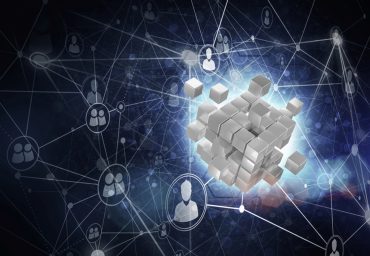Distributed ledger technology, such as that offered by blockchain, has the potential to help businesses address their growing master data management challenges.
In this RTInsights Real-Time Talk podcast, Joe McKendrick, industry analyst at RTInsights, and Dr. Setrag Khoshafian, Principal and Chief Scientist at Khosh Consulting, discuss the master data management challenges that most companies are dealing with today. Noting that as more sources of data are incorporated into business processes, current bottom-up approaches to master data management are limited. As a result, there is growing interest in the use of distributed ledger technology, such as that offered by blockchain.
Listen to the podcast now:
Subscribe to Real-Time Talk on your favorite platform:
About Setrag Khoshafian:

Dr. Setrag Khoshafian is Principal and Chief Scientist at Khosh Consulting. He is a pioneer and recognized expert in the transformation of innovative and agile enterprises. He has invented pragmatic approaches for innovation and cultural transformation through a holistic approach leveraging Intelligent Business Process Management, Intelligent Database Management, Internet of Things (IoT), Blockchain, AI, Low Code/No Code, Service-Oriented Architectures and Automation. Previously he was the Chief Evangelist & VP of BPM at Pegasystems Inc., the Senior VP of Technology at Savvion, and Chief Scientist & VP of Development at Portfolio Technologies.
Read the transcript:
Joe McKendrick: Hello, and welcome to the RTInsights Real-Time Talk podcast series. I’m Joe McKendrick, industry analyst at RTInsights, and your host for today’s discussion about master data management and blockchain.
Now you typically don’t think of these two topics as intertwined, but today’s guest will explain to us how blockchain can potentially lay the groundwork for inter-enterprise MDM on a much larger scale than we ever imagined.
So, I’m pleased to welcome Dr. Setrag Khoshafian, principal & chief scientist at Khosh Consulting. He is a pioneer and recognized expert in the transformation of innovative and agile enterprises. Welcome Setrag.
Setrag Khoshafian: Great to be here, Joe. It’s a real pleasure. And I’d like to take this opportunity also to thank RTInsights. I’ve been a part of the Brain Trust, and you guys are doing a great job really educating the market in the leading digital technologies. I’m really appreciative of that.
Joe: Well, thank you very much. We appreciate that. And it’s really great to have you on this show, Setrag. And I just want to mention to our audience that you have also conducted a highly insightful Ted Talk. You can find that on YouTube, under the topic of how culture always trumps technology.
And Setrag, why don’t you tell us a little bit about yourself and the work you’ve been doing in the digital transformation space?
Setrag: Sure. And so I’ve been in this industry too long. Decades and decades. And I started in database. My research has been in advanced databases, intelligent databases, and I did some innovations there like Intelligent SQL, object-oriented databases. I’ve written about five books on databases alone, and did some very interesting work in that area, both in terms of research, as well as in terms of product. And I started getting also into multimedia, hypermedia, document imaging workflow, and did a number of initiatives there, a part of startups. I invented the world’s first web-centric BPM product. It was the foundation of what came to be known as Savvion, which at that time was the leader. This is 2001, 2002 timeframe. And then I joined Pega and I was the chief evangelist and vice pres[ident] … Actually, I came to Pega as vice president of BPM technology.
I’ve done a lot of work in BPM, both in terms of startup, being the innovator and inventor of a BPM product, as well as on methodology side, technology side, how it relates to service-oriented architectures. I wrote a book called Service Oriented Enterprises, which is still available. I did that around 2006. And I’ve been doing a lot of working with Fortune 500, Fortune 1000 technologies, doing a lot on digital transformation, both from technology and methodology perspective.
Recently, I’m so excited: I’ve joined two of my sons, and we’re involved in both start-up entrepreneurship, as well as innovation initiatives. And it’s a relatively new company. We have a number of initiatives going on in that domain.
But we see a number of… in fact, I see four technologies that are really coming together, and I reflect a lot of these in my RTInsights articles, and those are really occupational intelligence, of course. Goes without saying, whatever it means, as well as internet of things, blockchain, and automation, including process automation, but there are other categories of automation as well. Sorry, Joe, I took a little bit longer, but that sort of gives you a perspective of the things that I’m involved in.
Joe: Well, yeah. You’ve certainly been on the cutting edge of many things over the years. And … Wow, and things are still constantly changing. It’s nice to hear that you’re totally engaged with helping enterprises figure out what’s going on, and what they need to know.
And let’s get reacquainted a bit with the concept of master data management, MDM. Folks in the enterprise data space … And you’ve been a database expert for many years, as well, so you what’s going on here. Folks have been talking about the need for master data management for some time now. Having a single “gold copy” of information, if you will, if you want to call it that, at the center of things, but it seems we never can quite get there. We never can quite make it to MDM. How important is master data within enterprises?
Setrag: That’s such an astute observation, Joe, because as I told you, I have dealt with a lot of Fortune 500, Fortune 1000 companies. I cannot think of a single one who doesn’t have a master data management problem. And as you highlighted, you want … There are so many sources of data for the same entity. That entity could be a customer, could be a product, could be a partner, could be a service, could be a supplier. So, think of a large organization, which has many systems of record, many homegrown databases, and they have the information about the same customer, or the same product, or the same supplier … You name it. Anything that the enterprise deals with, in different systems.
I’ll explain the problem of master data management, which is so compelling and pervasive, through a very simple example. Every time you call the call center of an organization, you have a complaint, etc., and they take your credentials, and then you probably called in because it’s an exception; it’s a difficult case. They transfer you. And then when they transfer you, they ask for your credentials again. And it’s likely that they’ll transfer you again, and they’ll ask for your credentials again. So that tells you that there is not one single system that contains your information.
In fact, I remember during the eCommerce era, that still exists today. Many applications were developed independent of each other, but dependent upon the channel. That meant, for certain products in the organization, if you went through one channel, if you don’t have any master data, you would get one price. If you went to another channel, you’ll get another price. So, the need, for many reasons, from the customer experience, because you will be actually quite upset if you go to one channel, for instance, and change your address and find out in another channel that they don’t have your new address. They still have your old because they don’t have master data. And that applies to partners, applies to product, that applies to services, almost any domain.
So, organizations, how do they solve this in the enterprise? We’re not talking blockchain. I’ll come to blockchain in a moment. But just within the enterprise, how do they solve it? Well, often they take very much a bottom-up approach, in the sense that, what are all the systems of record, all the databases that we have, that have information about customers? Let’s create one super one; a master data one, and aggregate all of these. And there are categories. There is software which does master data management. Now it is very important that we … Were you going to say something, Joe?
Joe: Oh, I’m sorry. I couldn’t agree with you more. And if I had a dollar for every time I’ve had the constant repeat my information to customer service departments over the years, I’d be quite wealthy.
Setrag: Yes. And isn’t it amazing that it still persists, despite all these digital technologies? So, couple of other things, Joe, before we move on because … And by the way, I have a couple of articles on this on RTInsights. One is called Process + Data: It’s About Time! and the part two of that is Process + Master Data. And the point I wanted to make there is that it’s not just the data that needs to be consistent and a single version of the truth for all your entities: your customers, your suppliers, your product, your services, whatever it is. That’s what a company in aggregation, in terms of the data of all of these. You also need the various policies, and the business rules associated with these entities to be consistent. So, that’s why you don’t want to get a discount going through one channel. And so that’s a business logic.
And so you have the data problem … Always these two go together, right, Joe? The data, and the execution of the data, right?
Joe: Yes.
Setrag: So, you want consistency in that, as well. In fact, I introduced a while back this notion of master policy management, or master business logic management. It’s not just the data. The data is a big problem, and headache in itself, but now you might have business logic in different systems of record on homegrown systems, and these need to be in … Especially these days for compliance, GDPR, etc., it’s extremely important and critical. So, it a major headache. And there are not only bottom-up approaches, but top-down approaches, where you can look at the processes that go across various, let’s say, systems of record within the organization, and achieve the effect of a master data within those processes. So, I touch upon that in those articles, but that just gives you a feel of the seriousness of this challenge, and the potential approaches, how organizations are solving them.
Joe: Okay, great. Yeah. A big problem. And it’s been a big problem for some time as you point out. Okay. Nowadays we have this thing called blockchain. It’s arrived on the scene in a big way in recent years More broadly it’s referred to as distributed ledger technology. It isn’t necessarily a blockchain, but there’s a whole assortment of DLT-type solutions out there. How is this all coming together now? How is blockchain, or DLT technologies, going to solve this data issue that we’re having in organizations?
Setrag: Absolutely. So, as you pointed out, if you look at blockchain, and I’ve been, this is one of the hottest areas I’ve been concentrating on. I’ve looked at the technology extensively, experimented with it, been to conferences. And I should mention, Joe, it’s a very interesting culture, this blockchain culture. But if you look at the technology, as you described it, it’s rather boring, right? I mean, ledgers? You know?
Joe: Yes.
Setrag: I mean, come on. I’ve seen paper ledgers, whether in copy books and so on, in mafia movies. That’s how always they get them; they get the ledgers. And now we get them digitally, right? It sounded boring.
So, the reason—and I relate it to master data—it’s a major issue, and major player in that area, potentially, with its challenges. But before that, what you’re doing in blockchain, and I don’t want to spend too much time on it, people can read about it, Wikipedia, etc., but what you’re doing is you have a cryptography, of course. You’re recording transactions, or information about assets. What can assets be? You name it. They can be people, they can be real estate, they can be gold, they can be anything you want. They can be parts for manufacturing. You are conducting various transactions on these, and then you are collecting them in blocks, and you basically have a decentralized distributed database, which is a linked list of these blocks.
So, you have transactions exactly like you have in a ledger, what you did with it, and then you link them together. Now, there are a couple of things I should mention here, and it’s good to contrast this with a database management system. So, it’s not an object-oriented database, or a graph database, sort of similar to it in some ways, but it’s a linked list database, and it’s an immutable database. What does that mean? It means you cannot … In databases, we have this CRUD: create, read, update, delete. And there are, for example, in relational databases, SQL statements that do that. There is data definition and data manipulation. And in the data manipulation, you can do that. You can change things. You can change the values of attributes, or [inaudible 00:00:14:44]. You can’t do that in blockchain. Well, how do you do it? Well, you add entries. You create another transaction, and that gets validated, and it becomes part of the blockchain.
The history is always there. Sometimes, Joe, they say, “Well, blockchain is the new digital gold.” Yes and no. It’s not because if I have a piece of gold, I don’t know who owned it. I don’t have the whole history of who owned that piece of gold. With blockchain you do, although you might not know, but you will have an identity. You will know what was its history when it got transferred, so that’s a fundamental difference. So, everything is recorded. It’s a ledger and all of the changes … So, it’s immutable, of course it has other characteristics. It’s consistent, etc. So, let’s bring that to master … What in the world does this have anything to do with master data management? Well, the thing is, and this really gets into the very core of what is happening with blockchain.
So, let’s take a very pragmatic example. And since blockchain … By the way, blockchain is the technology that is leveraged in Bitcoin. So, historically Bitcoin used blockchain, and there are algorithms, proof of work, which it’s called, and there are a couple of them that are alternative algorithms to do the mining. Basically when I say mining, think of it as validation in the context of cryptocurrency. But soon people realized that you can leverage these decentralized, as you mentioned, Joe, really, decentralized and distributed … But it’s replicated. I should mention this. All the nodes… So, in blockchain, you have this architecture of nodes. All the nodes that participate, let’s say, in validating, have a copy of the entire ledger. Now there are some recent technologies that they’re doing, what we used to call declustering in databases. The term they use in the blockchain community is sharding.
And it’s breaking up—think of a tape—you break it up in horizontal stripes, to increase the performance. But at its core, the traditional … The traditional, it’s like 10-year old technology. But, the blockchain technology, it’s really is replication. It’s replication, and you have immutability, and all these replicas, there’s no single source of failure, so that’s very important. So, you are coming to this decentralization in the sense that if you have … People are asking, “Can I do this with a centralized pool? Put a data center on the cloud, and just use that?” The answer is yes, of course you can do it. But how many times we’ve heard of catastrophes, right, when it was hacked? I mean, that’s one of the advantages you have here. It’s decentralized. Even if one of the nodes goes down, you have a copy.
And it’s like, if I ask, “Who owns the internet?” Nobody owns the internet. I used to, in university of… Nobody owns it, that there are standardization bodies, governance bodies, etc. It started with, with the ARPANET and CSNET, but then it evolved. But nobody owns it. It runs on its own. And one analogy I want to give, blockchain is very much seen as part of the evolution of the internet. One way to categorize it, and I’ve used it, is you went from the internet of information, to the internet of things, to the internet of value. That value does not necessarily mean cryptocurrency. That’s part of it. But value is also in this ability to have the decentralization paradigm. I’ll come to an example, and maybe that will clarify. Think about how banks do know your customer today, without blockchain.
So, you have to go through a business regulation. You have to go through the process. You submit your documents, etc. You create an ID for you. And then they validate you. Everything is okay, then you can open the account, checking, savings, etc. Now, you want to conduct business with another bank? You have to go through the same process again. They have nothing to do with each other.
What are we lacking in this? And I’m using this analogy to explain the linkage between blockchain and master data, master information management. That, in this example I’m giving, competitors will leverage. Now, if you have that secure, immutable, pictographic entries for knowing your customer, different banks can leverage it. And actually there are examples of this, especially in Asia, where they are competitors, yes, but they’re leveraging that master of knowing your customer across the various banks. That is very powerful. It is immutable. It is secure, and this is one of the examples … So, think about, let’s say you purchase a car, let’s say, and then you want to know all the information about the car, and different organizations might be sharing that information.
It could be part of the supply chain. It could be part of the servicing agents, dealers, etc. Well, how do people communicate? Well, they send, I don’t know, emails, faxes, documents. You can apply the same thing, Joe, for real estate. These are all examples of real use cases. To most of them, the “know your customer” is actually in production. A lot of these examples I’m giving are really in proof of concept. So, I should point that out, that blockchain is a very exciting technology. As I said, at its core is decentralized, distributed, linked list ledger. But it is also relatively immature, and most organizations are looking into it. I just saw, I think I posted it, there are a lot of more … 40, 50 percent of organizations are looking into blockchain, and have at least pilots if not actual deployments.
So, you are getting a sense here: because it’s immutable. I’m not relying on any centralized … Nobody’s owning it. If I took that example, if one bank says, “I am the good guy, I’m the big guy. All of you, if you want to know your customer …” the other banks say, “No, why should we?” But if it’s decentralized, nobody owns [it]. Like the internet, that’s why I’m giving that analogy. Nobody owns it. It’s decentralized. It’s secure. It’s reliable. The bank says, “Okay, rather than us doing it again, we improve the customer experience and we leverage the blockchain.”
Joe: That’s fantastic. An independent, decentralized, immutable system of record that is available to any enterprise that needs it, and it enhances their ability to do work with their customers, as well as work with other organizations. The information is secure, yet it’s a single source of the truth.
Setrag: So, that’s where the link is. And one thing I should mention, Joe. I did the analogy of the internet: internet of value, internet of things, and of course, internet of information, the traditional internet. And, in fact, another analogy is that if you look at the internet technology, my university, University of Wisconsin, was involved in … it’s rather boring. TCP/IP, SMTP, HTTP. Those are boring, but the internet is a paradigm. A paradigm of search and sharing of information. And on top of that, we’ve built the eCommerce, and now we are having another revolution, in my opinion, both with web applications and blockchain. Blockchain is often called Web3. Now, the point I want to make here is that many people don’t realize it, there is no single blockchain. I mean, Bitcoin, in terms of cryptocurrency, is probably the biggest, Ethereum is the second. That’s the cryptocurrency side.
And then there are all these permissions blockchains within consortia, and organizations like the banks I mentioned in Asia, who share “know your customer” information. These are called more like permission. It’s a similar concept: decentralized, you have nodes, you have a link list, immutable, secure, etc., but it’s not public. It’s a permission, private blockchain. So, there is the contrast between these two. But, it’s essentially the same. Because there’s not a single one. Right? Ethereum has its own blockchain. Bitcoin does its own blockchain. So, when we talk about the internet, it’s “the internet,” but there’s nothing called “the blockchain.” There are blockchains. And there is now an emerging technology, there’s so many of them by the way, that are, sort of, I would say, the companion technologies that are necessary. One of them is the ability to have a blockchain of blockchains—like a layer. A famous computer scientist wants that every problem in computer science can be solved with an extra level of indirection. So, it creates another …
Joe: It gets all very meta, right?
Setrag: Yeah, exactly. It’s too hard? Go one layer up.
Joe: That’s great. Okay so, Setrag, we’ve come to the end of our session here. I really want to, again, express our appreciation. It’s been great having you here explaining how this all weaves together and how blockchain offers a very dynamic and a strong solution for the master data management problem.
Again, I want to thank you for joining us, Dr. Setrag Khoshafian of Khosh Consulting. Also, a contributor to RTInsights, as he mentioned, and very much a mover and shaker in our industry. Thank you very much, Setrag.
Setrag: Thank you, Joe. It was a pleasure. Let’s do this again. I enjoyed it immensely. Thank you very much.
Joe: I’d love to. Thank you.
Setrag: Okay. Perfect.































